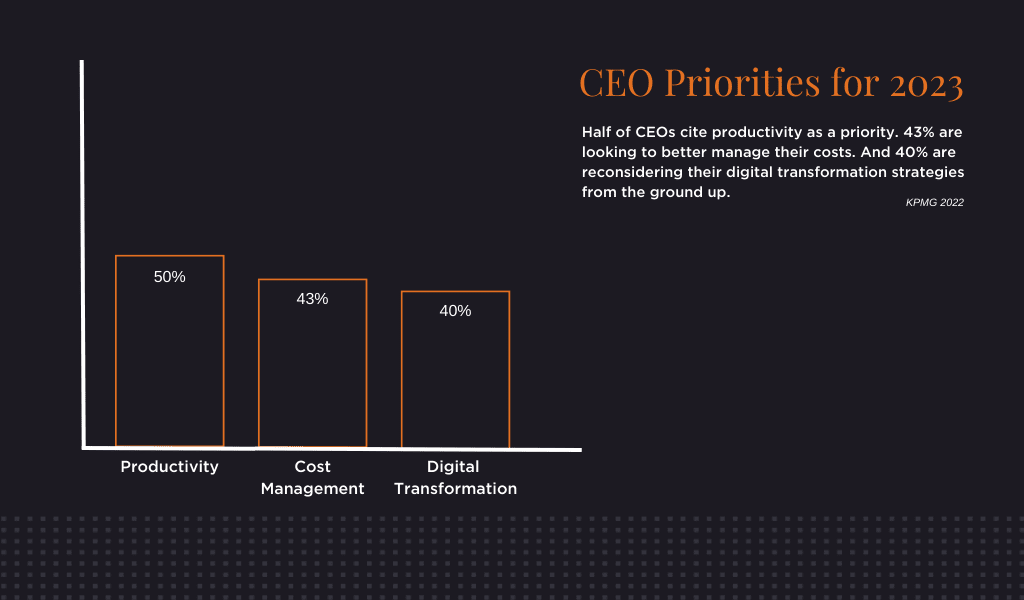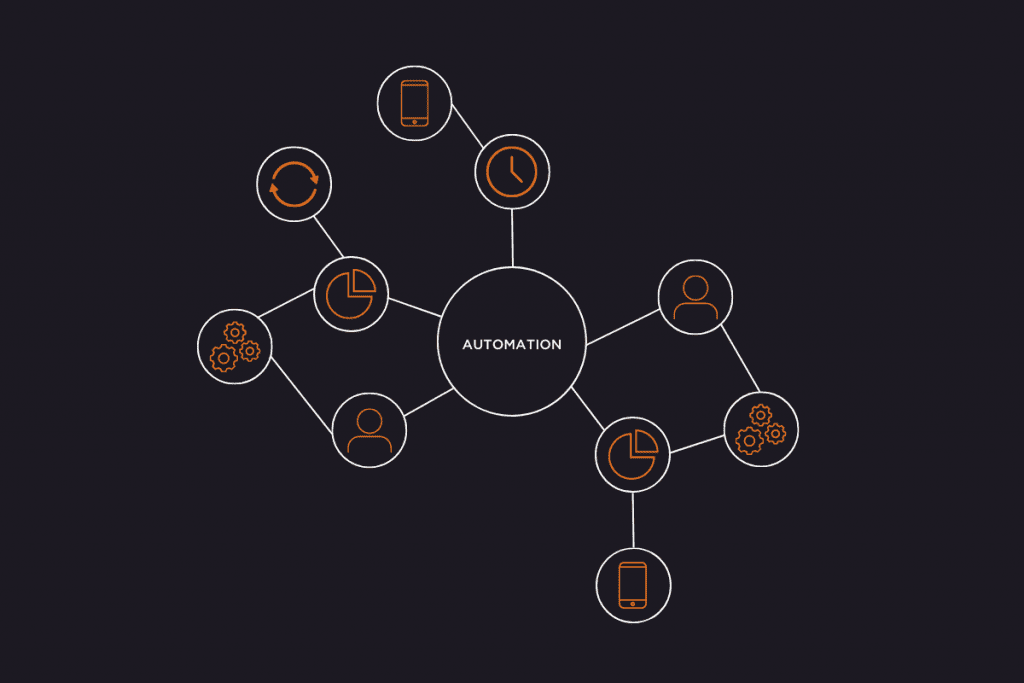Automation – when done right – amplifies the impact of every person in your organisation. It will play a critical part in safeguarding your company against the effects of the upcoming recession. But doing it right demands a deep understanding of how your people work and what they’re trying to achieve.
The majority of c-suite leaders expect a recession in the next year. Seven out of ten CEOs expect this recession to disrupt their growth. But despite the looming recession, the c-suite’s outlook is positive and their priorities are clear.
Under pressure to deliver more for less in 2023, half of CEOs cite productivity as a priority. 43% are looking to better manage their costs. And 40% are reconsidering their digital transformation strategies from the ground up.
It’s no surprise then that more and more businesses are turning to automation to unlock extra productivity within their workforces, cut operating costs, and provide a higher return on technology.

What is Automation?
Automation is when you use the right technology to make repetitive and manual tasks less work for everyone involved. It frees your people up to focus on the parts of their jobs that are more enjoyable for them and more valuable for your business.
In every business, there are inefficient processes that people follow again and again – even when they know there’s a better way. They do this because the time and effort it takes to fix a broken workflow or streamline a low-value task often outweighs the time and effort to do it the wrong way once. Thanks to this imbalance, people find themselves trapped in a cycle of doing tasks the wrong way just one more time. That is, until the next time they need to carry out the task and there’s a deadline looming. Then, it’s just one more time, one more time.
To solve this productivity problem, many organisations will turn to technology. But they’ll do it without the right approach or digital strategy required for it to be successful. To succeed, you have to understand the benefits you want to get from automation. A list of features isn’t enough. You need a clearly defined product that supports the desired outcomes you want to achieve. You need a solution that brings real value and benefits.
3 Benefits of Automation

Increase Productivity
Automation frees your people up to focus on what they do best by cutting the time and effort it takes to complete mundane, repetitive, and error-prone tasks. It’s estimated that in almost two-thirds of jobs, a third of tasks can be automated.
These tasks – which, while important, are often not the best use of your workforce’s time and skills – can be done faster and to a higher degree of accuracy through automation. The less time spent completing and checking these tasks, the more time your workforce can spend on complex, valuable, and rewarding activities.
Slash Operating Costs
The average human makes about 118 mistakes at work every year. These errors – which range from incorrect data inputs and simple spelling mistakes to massive security breaches – are estimated to cost companies trillions.
When done right, automation replaces manual and error-prone processes with a consistency and accuracy that can’t be matched. And with the ability to run automations on-demand around the clock, so much data processing work can be done in the background. This frees up workers to focus on interpreting and acting upon the data with the confidence that it’s correct.
So, not only does automation reduce the time it takes for workers to complete key activities, but it also reduces the time required to check and amend the work. And all the while, it creates a comprehensive digital history of every activity where before all you had was a patchy paper trail.
Improve Customer Experience
The benefit of the more productive, efficient internal work we’ve explored so far is that it passes on to your customers. 71% of B2C and 86% of B2B customers expect you to be well-informed about their personal information when they interact with you. The faster and more accurately your customer-facing teams can retrieve this information, the more proactively they can deal with issues.
The same goes for the tools and platforms that your customers interact with. Here, automation can be applied directly to the customer experience to create significant wins and serve up memorable and delightful moments.
Simple automations at the right time and place, and powered by accurate customer data, improve end-experience because customers get the service and support they need much faster. This helps you to win more new customers and keep existing ones.
Automation. Not Digitisation.

Whether you’re looking to increase productivity, cut operating costs, improve customer experience or tackle all three, automation is not without its own set of challenges.
The main challenge is building the right product. Despite being done with the right intention, many solutions don’t deliver the expected benefits. Some even introduce new challenges themselves.
How do companies end up building the wrong thing? Often, it’s by confusing digitisation and automation. These two are not synonymous.
Just because you digitise a process, it doesn’t make it better or more efficient. Automation has to add real value. Companies that confuse the two are the reason why 28% of software goes unused.
How does this critical mistake keep happening? More often than not, it’s caused by companies starting with an idea, solution, or perceived benefit and working backwards to the problem or workflow – without consulting or considering the people it’s supposed to help.
To reap the benefits of automation, you have to understand the problem you’re trying to solve and the people you want to support. You have to take the right approach.
The Right Approach
The right approach to automation starts with product discovery. This starts with your overarching business goals – not with the technology and not in the details.
Begin by identifying the specific benefits you want to unlock and agree on those that will have the greatest impact on your business. Once you have these high-level strategic priorities in place, then you can dive into the processes you want to improve – both from an internal and a customer-facing perspective – and the people you will need to support throughout them.
Build personas for the users you want to support and create a detailed user journey map to document the processes they’re following now. This will highlight the challenges that need solving as well as the delightful moments that your automation solution can’t risk removing or replacing.
You can then prioritise the most painful of these processes based on how much they’re impacting the productivity and efficiency of your business or how much they’re hampering your customer experience. This gives you a list of the most pressing problems which you can start to ideate automotive solutions for.
Taking this approach to automation makes sure that your solution addresses the real, high-priority problems your people are facing in their day-to-day lives. It helps to remove personal bias and incorrect assumptions from the digital transformation discussion by framing the conversation around a clear set of people, processes, and priorities.
Get Started
If you’re exploring how automation can help your business to improve productivity, cut costs, and provide a better return on technology than you’re getting right now, let’s talk about approaching it the right way.
Since 2009, we’ve specialised in helping partners to build the right products that deliver the right results. That means building an automation strategy with a strong business case behind it – so that you can be confident in the value your solution will create for you, your customers, and your employees.